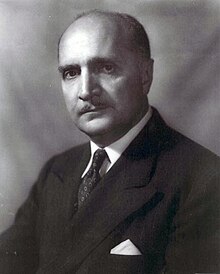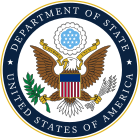Loy W. Henderson
Loy W. Henderson | |
|---|---|
 | |
| United States Ambassador to Iran | |
In office September 29, 1951 – December 30, 1954 | |
| President | Dwight D. Eisenhower |
| Preceded by | Selden Chapin |
| Succeeded by | Henry F. Grady |
| United States Ambassador to India | |
In office November 19, 1948 – September 21, 1951 | |
| President | Harry S. Truman |
| Preceded by | Chester Bowles |
| Succeeded by | Henry F. Grady |
| United States Minister to Iraq | |
In office November 20, 1943 – April 7, 1945 | |
| President | Franklin D. Roosevelt |
| Preceded by | George Wadsworth II |
| Succeeded by | Thomas M. Wilson |
| Personal details | |
| Born | (1892-06-28)June 28, 1892 Rogers, Arkansas, U.S. |
| Died | March 24, 1986(1986-03-24) (aged 93) Bethesda, Maryland |
 |
| U.S. Near Eastern Affairs Diplomats |
|---|
Loy W. Henderson (1922–1960) James Steinberg (2009–present) |
Loy Wesley Henderson (June 28, 1892 – March 24, 1986) was a United States Foreign Service Officer and diplomat.
Contents
1 Early life
2 Diplomatic career
2.1 Eastern Europe and Moscow
2.2 Near Eastern Affairs
2.3 Summary
3 References
4 External links
Early life
Henderson was born in Rogers, Arkansas in 1892 to a poor Methodist preacher. He attended college in a small town in Kansas before transferring to Northwestern University. An arm injury prevented him from fighting in World War I, so he served as a Red Cross volunteer instead.[1]
Diplomatic career
Eastern Europe and Moscow
Henderson joined the United States Department of State in 1922. After his initial consular tour in Ireland, he began a twenty-year focus on Soviet and Eastern European Affairs. Henderson then investigated the connection between the Soviet Comintern and left wing organizations in the United States while serving in Latvia, Lithuania, and Estonia.
In 1933, the Roosevelt Administration extended diplomatic recognition to the Soviet Union and Henderson was assigned to Russia to help reopen the U.S. Embassy in Moscow. Aiding him in this task were fellow junior officers George F. Kennan and Charles Bohlen, who along with Henderson would later be considered the Department's top Soviet specialists. In 1935, the Kremlin broke its pledge to not to interfere in U. S. domestic politics. In response, Ambassador Bullitt returned to Washington in disgust, leaving Henderson for a time as chargé d'affaires in Moscow. As chargé, Henderson warned Washington that the Soviet Union was likely to cooperate with Nazi Germany. Four years later, Moscow signed the Soviet-German Non-aggression Pact of 1939. Henderson was one of the contributors to the Welles declaration of 1940, which established US non recognition policy of Baltic states occupation by Soviet Union.
Henderson deeply distrusted the Kremlin and was at odds with the enthusiasm most Americans—and President Roosevelt—had in early 1942 for their new Soviet wartime allies. Eleanor Roosevelt and other Soviet sympathizers in the White House pressured the State Department to transfer Henderson out of the Soviet section. As a result, Henderson was sent to Baghdad as the U.S. ambassador to Iraq.[2] "A man of the highest character, absolutely incorruptible....Overruled time after time, he asked in 1943 to be relieved of his duties as chief of the division".[3]
Near Eastern Affairs
In between serving as U.S. Minister in Iraq (1943–45), Ambassador to India (1948–51) and Ambassador to Iran (1951–54),[4] Henderson returned to Washington in 1945 to serve at the State Department as the director of the Office of Near Eastern Affairs.
In 1945, Syrians in Damascus led an uprising against French rule. In response, French forces bombed Damascus. Henderson, as head of Near Eastern Affairs, advised President Harry Truman to force the French to withdraw. Henderson argued that the French bombing undermined not only the newly created United Nations but also the West's relations with the Arab world. Henderson correctly predicted that if the West did not maintain close relations with Syria, it would fall into the Soviet sphere.
In early 1946, Soviet troops advanced south to the outskirts of Tabriz in northwestern Iran, sparking an early Cold War stand-off known as the Iran crisis. Henderson showed the Truman administration how such movements threatened Turkey, Iraq, and the Iranian oil fields. Following Henderson's advice, Truman issued a stern warning to Stalin. Stalin thereafter pulled back his troops.
In late 1946, the Kremlin attempted to bully Ankara into ceding territory in eastern Turkey and control of the Dardanelles, which would have given Moscow its long-desired warm water port. Henderson, with Acting Secretary of State Dean Acheson, convinced Truman to express support for Turkey and to dispatch navy units to the eastern Mediterranean. In response, the Soviets withdrew some of their demands.
In 1947, the British embassy in Washington informed Henderson that the United Kingdom was no longer able to bolster the pro-Western forces against the Communist agitators in the Greek Civil War. Once again, Henderson convinced Truman to actively defend Western interests in the Mediterranean against Soviet encroachment. Henderson designed the Truman Doctrine plans to strengthen Greece and Turkey, an early move which would influence U.S. containment policy for decades to come.
In 1948, Henderson clashed with domestic groups lobbying for the creation of the state of Israel. Secretary of State George C. Marshall and Henderson, speaking for the Department of State, opposed the United Nations resolution dividing Palestine into Jewish and Arab states, as they felt Israel would not be able to defend itself and would ruin Washington's relationships with the Arab world; their view was that the area should remain a trust under the UN. On the other side, Presidential advisors such as David Niles and Clark Clifford, along with American Jewish groups and much of the general public, favored the partition of Palestine into the State of Israel and an Arab state. Henderson was harshly criticized for his opposition to the creation of Israel. His views did not prevail in 1948 and his transfer to the ambassadorship for India was rumored by his supporters to have been the result of political pressure from the pro-Zionist groups.[5] In 1954, he was appointed as Assistant Secretary of State for Administration.[6] In 1956, he was named a Career Ambassador.[7] He retired in 1960 and spent seven years teaching International Relations at Washington, D.C.'s American University. His memoirs, entitled "A Question of Trust: the origins of U.S.-Soviet diplomatic relations" were published in 1986.[8]
Henderson returned to the Middle East in 1951 as Ambassador to Iran. There he dealt with the newly elected prime minister, Mohammed Mossadegh, on questions associated with Iran's oil reserves previously owned by British interests that Mossadegh had recently nationalized. The United States was opposed to the nationalization,[9] and he helped orchestrate the 1953 CIA-assisted coup which removed Mossadegh, a democratically elected leader.
Henderson retired from the U.S. Foreign Service in 1957 and died in 1986, at the age of ninety-three.
The major auditorium in the State Department Harry S Truman Building headquarters is named in his honor.
Summary
| Position | Host country or organization | Year |
|---|---|---|
| US Consular Service | Dublin, Ireland | 1922 to 1924 |
| US Foreign Service | Riga, Latvia | 1924 to 1927 |
| US Foreign Service | Kovno, Lithuania | 1927 to 1930 |
| US Foreign Service | Tallinn, Estonia | 1930 to 1933 |
| US Foreign Service | Moscow, Soviet Union | 1934 to 1938 |
| US Foreign Service | U.S.A., Eastern European Affairs Bureau | 1938 to 1943 |
| US Foreign Service | Moscow, Soviet Union | 1943 |
| U.S. Ambassador | Baghdad, Iraq | 1943 to 1945 |
| US Foreign Service | U.S.A., head of Near Eastern Affairs Bureau | 1945 to 1948 |
| U.S. Ambassador | New Delhi, India | 1948 to 1951 |
| U.S. Ambassador | Tehran, Iran | 1951 to 1954 |
| US Foreign Service | U.S.A., Deputy Under Secretary of State for Administration | 1955 to 1960 |
References
^ Brands, H. W. (1991). Inside the Cold War: Loy Henderson and the Rise of the American Empire, 1918–1961. London: Oxford University Press. p. 15. ISBN 0-19-506707-X..mw-parser-output cite.citation{font-style:inherit}.mw-parser-output q{quotes:"""""""'""'"}.mw-parser-output code.cs1-code{color:inherit;background:inherit;border:inherit;padding:inherit}.mw-parser-output .cs1-lock-free a{background:url("//upload.wikimedia.org/wikipedia/commons/thumb/6/65/Lock-green.svg/9px-Lock-green.svg.png")no-repeat;background-position:right .1em center}.mw-parser-output .cs1-lock-limited a,.mw-parser-output .cs1-lock-registration a{background:url("//upload.wikimedia.org/wikipedia/commons/thumb/d/d6/Lock-gray-alt-2.svg/9px-Lock-gray-alt-2.svg.png")no-repeat;background-position:right .1em center}.mw-parser-output .cs1-lock-subscription a{background:url("//upload.wikimedia.org/wikipedia/commons/thumb/a/aa/Lock-red-alt-2.svg/9px-Lock-red-alt-2.svg.png")no-repeat;background-position:right .1em center}.mw-parser-output .cs1-subscription,.mw-parser-output .cs1-registration{color:#555}.mw-parser-output .cs1-subscription span,.mw-parser-output .cs1-registration span{border-bottom:1px dotted;cursor:help}.mw-parser-output .cs1-hidden-error{display:none;font-size:100%}.mw-parser-output .cs1-visible-error{font-size:100%}.mw-parser-output .cs1-subscription,.mw-parser-output .cs1-registration,.mw-parser-output .cs1-format{font-size:95%}.mw-parser-output .cs1-kern-left,.mw-parser-output .cs1-kern-wl-left{padding-left:0.2em}.mw-parser-output .cs1-kern-right,.mw-parser-output .cs1-kern-wl-right{padding-right:0.2em}
^ Kaplan, Robert (1995). The Arabists : The Romance of an American Elite. New York: Free Press. ISBN 0-02-874023-8.
^ Bohlen, Charles E. (1973). Witness to History 1929–1969. W. W. Norton & Company. ISBN 0-393-07476-5.
^ Office of the Historian. "Loy Wesley Henderson (1892–1986)". Department of State.
^ Harry S. Truman Library, Oral History Interview of Edwin M. Wright, July 26, 1974
^ Assistant Secretaries of State for Administration
^ Career Ambassadors
^ "A Question of Trust"
^ Abrahamian, Ervand (2013). The Coup: 1953, the CIA, and the roots of modern U.S.-Iranian relations. New York: The New Press. p. 97. ISBN 978-1-59558-826-5.
External links
The Political Graveyard - Short summary of details.- Loy W. Henderson: A Register of His Papers in the Library of Congress
Oral history interviewfrom 1973 at the Harry S. Truman Library.- Memoirs of Loy W. Henderson in the Library of Congress
- A brief biography by William N. Dale
Loy W. Henderson at Find a Grave
| Diplomatic posts | ||
|---|---|---|
| Preceded by Thomas M. Wilson | United States Minister to Iraq November 20, 1943 – April 7, 1945 | Succeeded by George Wadsworth II |
| Preceded by Henry F. Grady | United States Ambassador to India November 19, 1948 – September 21, 1951 | Succeeded by Chester Bowles |
| Preceded by Henry F. Grady | United States Ambassador to Iran September 29, 1951 – December 30, 1954 | Succeeded by Selden Chapin |
| Government offices | ||
| Preceded by Isaac W. Carpenter, Jr. | Assistant Secretary of State for Administration January 26, 1955 – August 9, 1955 | Succeeded by Isaac W. Carpenter, Jr. |

